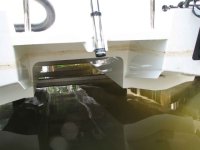Jeff,
Every hull configuration has some different results. While Bob of Thataway favors the more rounded tunnel shapes and the deeper hulls (or higher tunnel roof), those changes would alter the performance of the TC 255.
The closer you get to the rounded, deeper hulls, the more softness in control , similar to altering a single hulled craft from planing toward displacement contours.
If the hull/tunnel height was altered so that the tunnel completely cleared the water at low speeds, you would get more efficient hull speed performance, i.e., better miles per gallon at about 6 mph. That would be due to the reduction in wetted hull surface, and the less tectonic contours compared to the short legged, low tunnel TC 255 as it is now. You would also lose that HUGE forward bunk - almost 7X8 feet as it is now.
I think that the incredible feeling of stability at all hull speeds, from zero to maximum would be lost if one made these changes. Test drive a Glacier Bay - behaves more like a displacement vs. planing hull. Some advantages, some disadvantages - buy the one you like.
To my thoughts the TomCat's hull performance is in great part due to the low and squared tunnel. It gets pretty darned good mileage at 6-8 mph just as it is. The hulls seem to condense the waves and froth into an effervescent "pad" which supports the craft evenly upon planing with a faint buzzing, like riding on a million bumble bees. At a stop, as well as at all speeds, the lateral stability is remarkable. I, for one, would not want to change anything that could reduce these characteristics.
I guess the conversation is kind of like, "Why don't we make a Glacier Bay's hull more like a TomCat's hull?" in reverse. The family history of the TomCat is the Dory hull - flat, easy planing - and the TomCat is an extension of that. Planing hulls, semi-displacement and displacement hulls are different animals and are constantly being tweaked one way or the other in each new watercraft. Just buy the one whose performance matches your desires/needs.
Re: Low setting transom
The original TomCat 24 was designed for lower horsepower, smaller and lighter engines more than the recent high horsepower, bigger and heavier four cycle engines. One reason for the Armstrong brackets was to increase aft flotation. Loaded, sitting at the dock, I think the TomCat 255 tends to sit low aft. Full fuel tanks, generator, fish boxes and ice boxes in the cockpit area worsen this. It is just the nature of the beast.
The TomCat 255, however heavily loaded, planes easily at fairly low speeds and runs pretty flat and economically with level Permatrims.
Most local ppl who want to tour my TC 255 love how close the cockpit is to the water. Easy to fish and feels like you are almost right in the water.
While, I'd like to have a fully loaded boat that sits exactly level, there are few on the surrounding docks that will do so when heavily loaded. To reduce this, you could put less fuel in the tanks. How often do you need to go 300 miles without refueling? You could put more storage weight forward (right now I keep nothing in the underbunk or anchor side storage lockers).
I have not had anyone who operated my TC255 desire anything different in performance. Better to have a bit lighter bow in heavy seas too.
Test drive different cats. Evaluate them at rest, loaded and unloaded.
Just by carrying 100 gallons instead of 150 gallons, one can eliminate the low aft section at rest. Pretend you only have 100 fuel capacitY?
Good luck on your choice,
John

